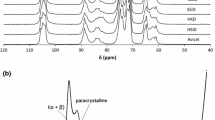Abstract
Fiber size analysis, water retention value, and Simons’ stain measurements were assessed for their potential to predict the susceptibility of a given substrate to enzymatic hydrolysis. Slight modifications were made to the fiber size analysis and water retention protocols to adapt these measurements to evaluate substrates for cellulolytic hydrolysis rather than pulps for papermaking. Lodgepole pine was pretreated by the steam and ethanol-organosolv processes under varying conditions. The Simons’ stain procedure proved to be an effective method for indicating the potential ease of enzymatic hydrolysis of substrates pretreated by either process or when the pretreatment conditions were altered.


Similar content being viewed by others
References
Boussaid A, Robinson J, Cai Y, Gregg DJ, Saddler JN (1999) Fermentability of the hemicellulose-derived sugars from steam-exploded softwood (Douglas-fir). Biotechnol Bioeng 64:284–289
Chandra RP, Bura R, Mabee W, Pan X, Berlin A, Saddler JN (2007) Substrate pretreatment: the key to effective enzymatic hydrolysis of lignocellulosics? Adv Biochem Eng/Biotechnol 108:67–93
Chandra RP, Ewanick S, Hsieh C, Saddler JN (2008) The characterization of pretreated lignocellulosic substrates prior to enzymatic hydrolysis part 1: a modified Simons’ staining technique. Biotechnol Progr 24:1178–1185
Converse AO (1993) Substrate factors limiting enzymatic hydrolysis. In: Saddler JN (ed) Bioconversion of forest and agricultural plant residues. CAB International, Wollingford, UK, pp 93–106
Dence CW (1992) The determination of lignin. In: Lin SY, Dence CW (eds) Methods in lignin chemistry. Springer-Verlag, Berlin, pp 33–61
Esteghlalian A, Bilodeau M, Mansfield SD, Saddler JN (2001) Do enzymatic hydrolyzability and Simons’ stain reflect the changes in the accessibility of lignocellulosic substrates to cellulase enzymes? Biotechnol Progr 17:1049–1054
Ewanick SM, Bura R, Saddler JN (2007) Acid-catalyzed steam pretreatment of lodgepole pine and subsequent enzymatic hydrolysis and fermentation to ethanol. Biotechnol Bioeng 98:737–746
Grethlein HE (1985) The effect of pore size on the rate of enzymatic hydrolysis of cellulosic substrates. Bio/Technol 3:155–160
Laivins GV, Scallan AM (1993) The mechanism of hornification of wood pulps. In: Baker CF (ed) Products of papermaking. Transactions of the 10th fundamental research symposium. Pira International, Oxford, pp 1235–1260
Mansfield SD, Mooney C, Sadder JN (1999) Substrate and enzyme characteristics that limit cellulose hydrolysis. Biotechnol Progr 15:804–816
Merino ST, Cherry J (2007) Progress and challenges in enzyme development for biomass utilization. Adv Biochem Eng/Biotechnol 108:95–120
Mooney CM, Mansfield SD, Beatson RP, Saddler JN (1999) The effect of fiber characteristics on hydrolysis and cellulase accessibility to softwood substrates. Enzyme Microb Technol 25:644–650
Mosier N, Wyman C, Dale B, Elander R, Lee YY, Holtzapple M, Ladisch M (2005) Features of promising technologies for pretreatment of lignocellulosic biomass. Bioresour Technol 96:673–686
Ogiwara Y, Arai K (1968) Swelling degree of cellulose materials and hydrolysis rate with cellulase. Text Res J 38:885–891
Pan X, Xie D, Yu R, Lam D, Saddler JN (2007) Pretreatment of lodgepole pine killed by mountain pine beetle using the ethanol organosolv process: fractionation and process optimization. Ind Eng Chem Res 46:2609–2617
Stone JE, Scallan AM, Donefer E, Ahlgren E (1969) Digestibility as a simple function of a molecule of a similar size to a cellulase enzyme. Adv Chem Ser 95:219–241
Yu X, Atalla RH (1998) A staining technique for evaluating the pore structure variations of microcrystalline cellulose powders. Powder Technol 98:135–138
Acknowledgments
The support of NSERC (Natural Sciences and Engineering Research Council of Canada) and NRCan (Natural Resources Canada) is gratefully acknowledged.
Author information
Authors and Affiliations
Corresponding author
Rights and permissions
About this article
Cite this article
Chandra, R.P., Ewanick, S.M., Chung, P.A. et al. Comparison of methods to assess the enzyme accessibility and hydrolysis of pretreated lignocellulosic substrates. Biotechnol Lett 31, 1217–1222 (2009). https://doi.org/10.1007/s10529-009-9993-5
Received:
Revised:
Accepted:
Published:
Issue Date:
DOI: https://doi.org/10.1007/s10529-009-9993-5




